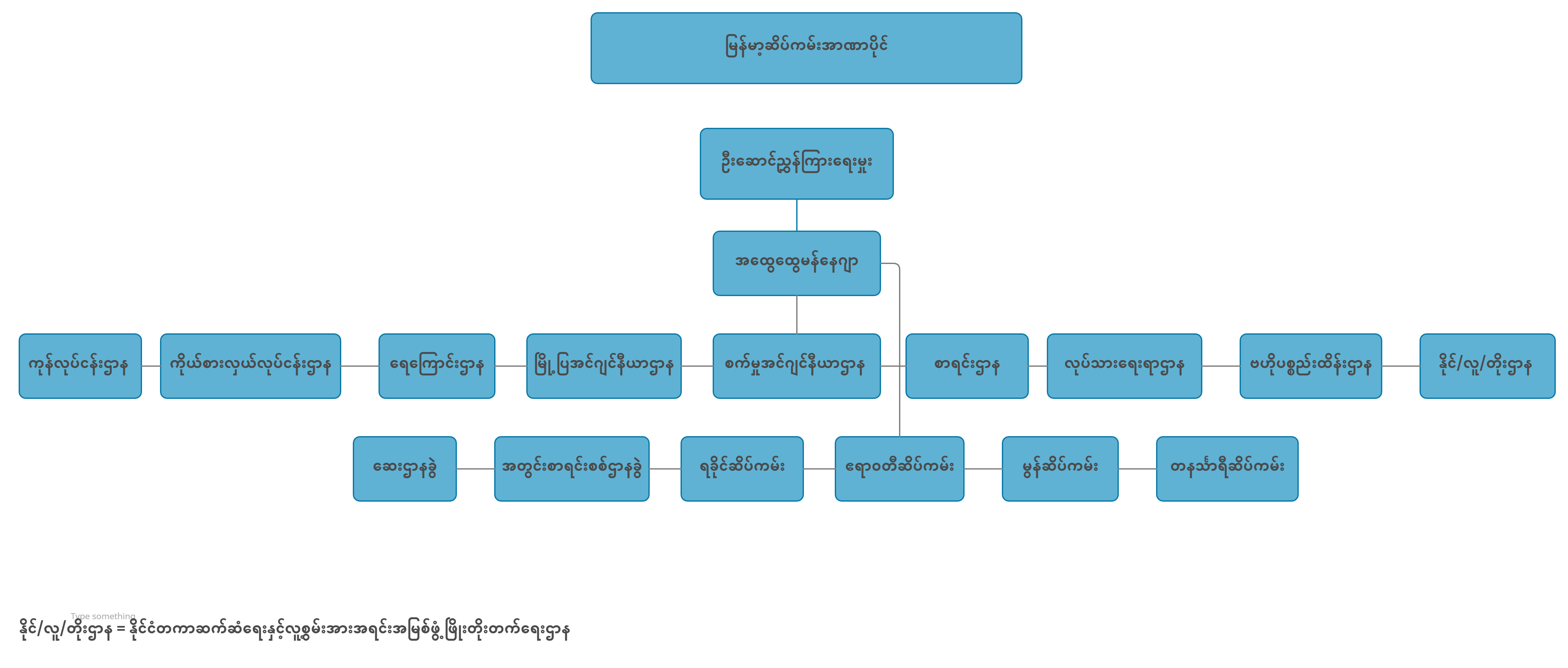
ပို့ဆောင်ရေးနှင့်ဆက်သွယ်ရေးဝန်ကြီးဌာန၏ ကြီးကြပ်မှုအောက်ရှိ နိုင်ငံပိုင် စီးပွားရေး အဖွဲ့အစည်း (၇)ခုအနက် တစ်ခုဖြစ်သည့် မြန်မာ့ဆိပ်ကမ်းအာဏာပိုင်သည် ကုန်သွယ်မှုနှင့် ကုန်စည်စီးဆင်းမှုများ အဆင်ပြေလွယ်ကူချောမွေ့စေရေးအတွက် နိုင်ငံတော်နှင့် ဝန်ကြီး ဌာန၏ မူဝါဒ၊ လမ်းညွှန်ချက်များနှင့်အညီ ဆိပ်ကမ်းဝန်ဆောင်မှုနှင့် စီမံခန့်ခွဲမှုဆိုင်ရာဥပဒေ၊ နည်းဥပဒေ များ၊ စည်းမျဉ်းစည်းကမ်းများကို ပြဋ္ဌာန်းထုတ်ပြန်ပြီး၊ ဆိပ်ကမ်းဝန်ဆောင်မှုပေးသူများနှင့် ဆိပ်ကမ်းသုံးစွဲသူများကို ကြီးကြပ်စီမံပေးခြင်း (Regulation)၊ အခြားအစိုးရဌာန/ အဖွဲ့ အစည်းများ နှင့်ပူးပေါင်း၍ ပံ့ပိုးဆောင်ရွက်ပေးခြင်း (Facilitation)နှင့် ဆိပ်ကမ်းများသို့ ဝင်ထွက်ကြသည့် အပြည်ပြည်ဆိုင်ရာကုန်သွယ် သင်္ဘောကြီးများ ဘေးကင်းလုံခြုံစွာဝင်ထွက် ဆိုက်ကပ် ထွက်ခွာ နိုင်ရေးနှင့် ကုန်တင်/ကုန်ချလုပ်ငန်းများ အဆင်ပြေချောမွေ့စွာ ဆောင်ရွက်နိုင်ရေးအတွက် ပုဂ္ဂလိ ကကဏ္ဍနှင့် ပူးပေါင်းပြီး ဝန်ဆောင်မှုများပေးခြင်း (Operation)လုပ်ခြင်းဖြင့် နိုင်ငံတော်အတွက် ဘဏ္ဍာငွေများ တိုးတက်ရှာဖွေပေးလျှက်ရှိနေပါသည်။
၁၉၈၈ ခုနှစ် မတိုင်မီ ဆိပ်ကမ်းလုပ်ငန်းများအားလုံးကို မြန်မာ့ဆိပ်ကမ်းအာဏာပိုင်မှ ဆောင်ရွက်ခဲ့သော်လည်း ၁၉၈၈ နှောင်းပိုင်းကာလများတွင် နိုင်ငံတော်မှ တံခါးဖွင့်စျေးကွက် စီးပွားရေးစနစ်ကို စတင်ကျင့်သုံးချိန်မှစ၍ ပြည်တွင်း/ပြည်ပမှ လုပ်ငန်းရှင်ကြီးများအား BOT၊ JV အစရှိသည့်စနစ်များနှင့် ဆိပ်ကမ်းဝန်ဆောင်မှုလုပ်ငန်းများတွင် ရင်းနှီးမြှုပ်နှံလုပ်ကိုင်ခွင့်များ ပေးအပ်ခဲ့ပါသည်။ ၁၉၉၆ ခုနှစ်နှောင်းပိုင်းမှစ၍ ပုဂ္ဂလိကဆိပ်ကမ်းတံတားများအနေဖြင့် နှစ် အလိုက် အဆက်မပြတ် ပေါ်ပေါက်လာခဲ့ရာ ယခုအခါ အစိုးရနှင့်ပုဂ္ဂလိက ဆိပ်ကမ်းတံတား ပိုင်ဆိုင်မှုအချိုးမှာ တံတားအရှည် မီတာ စုစုပေါင်း၏ ၉၄ % ကို ပုဂ္ဂလိကလုပ်ငန်းရှင်များမှ စီမံခန့်ခွဲလျှက်ရှိသည့်အတွက် ကျန် ၆ % သာလျှင် မြန်မာ့ဆိပ်ကမ်းအာဏာပိုင်၏ စီမံခန့်ခွဲမှုအောက်တွင် ကျန်ရှိပါသည်။ ထိုသို့ အစိုးရနှင့်ပုဂ္ဂလိကပူးပေါင်းဆောင်ရွက်မှု(Public-Private Partnership) ၏ အောင်မြင်မှုအသီးအပွင့်များအဖြစ် ရန်ကုန်ဆိပ်ကမ်းဧရိယာတွင် အပြည်ပြည်ဆိုင်ရာရေယာဉ်ကြီးများ ဆိုက်ကပ်နိုင်သည့် ဆိပ်ကမ်းတံတား(၂၈)စင်းနှင့် သီလဝါဆိပ်ကမ်းဧရိယာတွင် ဆိပ်ကမ်းတံတား (၂၀)စင်း စုစုပေါင်း သင်္ဘောကြီး (၄၈)စင်းအား တစ်ပြိုင်နက်တည်း ဆိုက်ကပ်ဝန်ဆောင်မှုပေးနိုင်နေပြီဖြစ်ပါသည်။
မြန်မာ့ကမ်းရိုးတန်းအရှည်သည် ရေမိုင်အားဖြင့် ၁,၂၆၀ မိုင်ရှိပြီး အဆိုပါ ကမ်းရိုးတန်းတစ်လျှောက်တွင် ဆိပ်ကမ်း(၉)ခုရှိသည့်အနက် ရန်ကုန်ဆိပ်ကမ်းသည် အဓိကနိုင်ငံတကာ ဆိပ်ကမ်းတစ်ခုဖြစ်ပြီး မြန်မာနိုင်ငံ ရေကြောင်းဖြင့် ကုန်သွယ်မှုပမာဏ၏ ၉၀% ရာခိုင်နှုန်းကျော်အား ကိုင်တွယ်ဆောင်ရွက်ပေးလျှက်ရှိသည့် ဆိပ်ကမ်းဖြစ်ပါသည်။
ရန်ကုန်မြို့သည် ၁၈ ရာစုအလယ်အထိ ဒဂုံဟု အမည်တွင်ခဲ့ပြီး တံငါသည် ရွာငယ်ကလလေးသာ ဖြစ်ခဲ့ကာ ဆိပ်ကမ်းမြို့အဖြစ် မတည်ရှိသေးဘဲ သန်လျင်၊ ပုသိမ်၊ မုတ္တမနှင့် ပဲခူး မြို့များကိုသာ ဆိပ်ကမ်းမြို့များအဖြစ် အသုံးချခဲ့သည်။ ၁၇၅၅ ခုနှစ်တွင် အလောင်းဘုရားမင်းသည် ဧရာဝတီ မြစ်တစ်လျောက်ရှိ ဒေသများကို သိမ်းပိုက်ရာမှ ဒဂုံသို့ ရောက်ရှိခဲ့ပြီး ရနန်ကုန်မြို့ဟုခေါ်တွင်စေကာ ပင်မဆိပ်ကမ်းမြို့များအဖြစ် စတင်တည်ထောင်ခဲ့သည်။


Maritime transport is the key pillar of international trade and global economy. According to UNCTAD’s Review of Maritime Transport, around 80% by volume and over 70% by value of international trade represent Maritime Trade, and these amounts are even higher for most developing economies. Reflecting this point, in Myanmar, maritime trade is the backbone of international trade and the country economy. In 2021, 71% of international trade is carried by sea whereas 29% of international trade goes through borders. Myanmar is a maritime country for its long coastline of 1,260 nautical miles. Among its nine ports, Yangon Port is a premier port that primarily handles international trade. Although Yangon Port is a river port, it has 27 berths with 4,640 metres of total quay length in its inner harbour, and 19 berths with 3,591 metres of total quay length in its outer harbour (Thilawa). With its adequate infrastructure and facilities and acceptable performance, the annual container handling capacity of Yangon Port is over 3 million TEUs whereas the annual general cargo handling capacity is over 12 million metric tons and 6 million metric tons of oil and gas storage capacity. Myanma Port Authority (MPA), as an incumbent authority of the port industry, has been constantly undertaking port development, with the vision of making its ports strategic land-sea gateways for the region, and international trade and logistics networks. In doing so, MPA as a regulator is regulating private port operators and port users; as a facilitator, it facilitates and promotes the seamless flow of maritime trade in cooperation with relevant government agencies; and as an operator, it provides safe and secure navigation services for all vessels and productive cargo handling services in cooperation with the private sector. Reflecting the outcomes of year-round maintenance dredging and upgrading navigation aids, channel safety has been improved. Today’s acceptable vessel size in terms of draft and LOA of the Yangon Port has increased since then MPA discovered a new approach channel, the Kings Bank Channel. Accepting larger- sized vessels results in economies of scale for all parties participating in maritime trade. Additionally, to develop a sustainable and resilient port community system, MPA is moving forward across the right track of digital transformation in documentation procedures as a part of the National Single Window and ASEAN Maritime Single Window together with participating port actors.


မြန်မာနိုင်ငံအား ဒေသတွင်းနှင့် နိုင်ငံတကာ ကုန်သွယ်မှု၊ ထောက်ပံ့ဖြည့်တင်းမှု ကွင်းဆက်တွင် အပြည့်အဝ ချိတ်ဆက်၍ အကျိုးဖြစ်ထွန်းစေနိုင်မည့် ဆိပ်ကမ်းများ ဖြစ်လာစေရန်။
